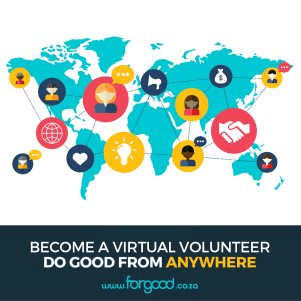- Home
- Campaigns
- Best Of Virtual Volunteering
- Stories
- History Of Virtual Volunteering

History of Virtual Volunteering
Virtual volunteering is not a new concept - the practice has been widespread for many years.
It has been going on probably as long as there has been an Internet (which itself is more than 30 years old.
The first instance of organized virtual volunteering is probably Project Gutenberg, a volunteer effort that began in 1971 to digitize, archive and distribute written cultural works. Most of the items in its collection are the full texts of public domain books, such as works by Jane Austen, Charles Dickens, Sir Arthur Conan Doyle and Mark Twain. These works continue to be typed in and proofread by online volunteers.
Tim Berners-Lee, who is credited as the inventor of the World Wide Web, made an online appearance at the United Nations Open Day in Geneva in 2001, during which he noted the role online volunteers had played in his development of the Web a decade earlier.
In 1995, a then-new nonprofit organization called Impact Online, based in Palo Alto, California, began promoting the idea of virtual volunteering , a phrase that was probably first used by one of Impact Online's co-founders, Steve Glikbarg. In 1996, Impact Online received a grant from the James Irvine Foundation to launch an initiative to research the practice of virtual volunteering and to promote the practice to nonprofit organizations in the United States. This new initiative was dubbed the Virtual Volunteering Project, and the Web site was launched in early 1997.
After one year, the Virtual Volunteering Project moved to the Charles A. Dana Center at The University of Texas at Austin, and Impact Online became VolunteerMatch. The first two years of the Virtual Volunteer Project were spent reviewing and adapting telecommuting manuals and existing volunteer management recommendations with regard to virtual volunteering, as well as identifying organizations that were involving online volunteers.
By April 1999, almost 100 organizations had been identified by the Project as involving online volunteers and were listed on the Project's Web site. By the end of 1999, as the numbers grew exponentially, the Project stopped listing every organization involving online volunteers and instead identified only those organizations with large or unique online volunteering programs.
The Project used its research about these organizations to continually create and refine guidelines for engaging and supporting online volunteers. Until January 2001, the Virtual Volunteering Project listed all telementoring, e-mentoring and teletutoring programs in the USA (in which online volunteers mentored or tutored others, through a nonprofit organization or school). At that time, 40 were identified. This was the first and only effort to list all such programs, and to track what made them successful.
There is, unfortunately, no longer any current research measuring how widespread the practice of virtual volunteering is in the USA or worldwide, and so this edition of the Virtual Volunteering Guidebook offers no statistics on such. Instead, we focus on what practitioners and academics have identified as essentials for the successful involvement of online volunteers.
Readers can find links to research articles and projects relating to virtual volunteering, including lists of organizations involving volunteers, in the appendices. The archived version of the 2001 list can be found at http://www.coyotecommunications.com/vv/direct/telem.shtml


